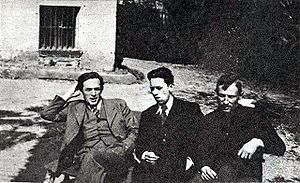
Jan Gralinski
Encyclopedia

Poland
Poland , officially the Republic of Poland , is a country in Central Europe bordered by Germany to the west; the Czech Republic and Slovakia to the south; Ukraine, Belarus and Lithuania to the east; and the Baltic Sea and Kaliningrad Oblast, a Russian exclave, to the north...
General Staff
General Staff
A military staff, often referred to as General Staff, Army Staff, Navy Staff or Air Staff within the individual services, is a group of officers and enlisted personnel that provides a bi-directional flow of information between a commanding officer and subordinate military units...
's interbellum Cipher Bureau
Biuro Szyfrów
The Biuro Szyfrów was the interwar Polish General Staff's agency charged with both cryptography and cryptology ....
's Russian section, B.S.-3.
After Poland
Poland
Poland , officially the Republic of Poland , is a country in Central Europe bordered by Germany to the west; the Czech Republic and Slovakia to the south; Ukraine, Belarus and Lithuania to the east; and the Baltic Sea and Kaliningrad Oblast, a Russian exclave, to the north...
was overrun by the German
Germany
Germany , officially the Federal Republic of Germany , is a federal parliamentary republic in Europe. The country consists of 16 states while the capital and largest city is Berlin. Germany covers an area of 357,021 km2 and has a largely temperate seasonal climate...
s and Soviets in September 1939, Graliński managed, along with other Cipher Bureau personnel, to reach Paris
Paris
Paris is the capital and largest city in France, situated on the river Seine, in northern France, at the heart of the Île-de-France region...
, France. He became part of the reconstituted Polish cryptologic unit that was housed during the "Phony War" in the Château de Vignolles, codenamed PC Bruno
PC Bruno
PC Bruno was a Polish-French intelligence station that operated outside Paris during World War II, from October 1939 until June 9, 1940. It decrypted German ciphers, most notably messages enciphered on the Enigma machine.-History:...
, at Gretz-Armainvillers, some forty kilometers northeast of Paris.
After northern France was overrun by German forces in May-June 1940, Graliński was one of the Polish cryptologic team that operated at Cadix
Cadix
Cadix was the codename of a World War II clandestine Polish-French intelligence center that operated at Uzès, on the Mediterranean coast in southern, Vichy France, for over two years from September 1940 to November 9, 1942.-History:...
in southern, Vichy France
Vichy France
Vichy France, Vichy Regime, or Vichy Government, are common terms used to describe the government of France that collaborated with the Axis powers from July 1940 to August 1944. This government succeeded the Third Republic and preceded the Provisional Government of the French Republic...
's "Free Zone."
Graliński perished in the Mediterranean Sea
Mediterranean Sea
The Mediterranean Sea is a sea connected to the Atlantic Ocean surrounded by the Mediterranean region and almost completely enclosed by land: on the north by Anatolia and Europe, on the south by North Africa, and on the east by the Levant...
, near the Balearic Islands
Balearic Islands
The Balearic Islands are an archipelago of Spain in the western Mediterranean Sea, near the eastern coast of the Iberian Peninsula.The four largest islands are: Majorca, Minorca, Ibiza and Formentera. The archipelago forms an autonomous community and a province of Spain with Palma as the capital...
, on January 9, 1942. He was returning to the Cadix center, near Uzès
Uzès
Uzès is a commune in the Gard department in southern France.It lies about 25 km north-northeast of Nîmes.-History:Originally Ucetia, Uzès was a small Gallo-Roman oppidum, or administrative settlement. The town lies at the source of the Eure, from where a Roman aqueduct was built in the first...
in southern France, from a stint at Cadix's branch office at the Château Couba on the outskirts of Algiers
Algiers
' is the capital and largest city of Algeria. According to the 1998 census, the population of the city proper was 1,519,570 and that of the urban agglomeration was 2,135,630. In 2009, the population was about 3,500,000...
. His passenger ship, the Lamoricière, sank in unclear circumstances. Fellow victims of the disaster, among the 222 passengers lost, included Piotr Smoleński
Piotr Smolenski
Piotr Smoleński was a cryptologist in the Russian section of the interbellum Polish General Staff's Cipher Bureau.He perished in the sinking of the passenger ship Lamoricière in the Mediterranean Sea....
, likewise of the prewar Cipher Bureau
Biuro Szyfrów
The Biuro Szyfrów was the interwar Polish General Staff's agency charged with both cryptography and cryptology ....
's Russian section, and Jerzy Różycki
Jerzy Rózycki
Jerzy Witold Różycki was a Polish mathematician and cryptologist who worked at breaking German Enigma-machine ciphers.-Life:Różycki was born in what is now Ukraine, the fourth and youngest child of Zygmunt Różycki, a pharmacist and graduate of Saint Petersburg University, and Wanda, née Benita. ...
of its German section, as well as a French officer accompanying the three Poles, Capt. François Lane.
In 1978 cryptologist Marian Rejewski
Marian Rejewski
Marian Adam Rejewski was a Polish mathematician and cryptologist who in 1932 solved the plugboard-equipped Enigma machine, the main cipher device used by Germany...
, of the prewar Cipher Bureau
Biuro Szyfrów
The Biuro Szyfrów was the interwar Polish General Staff's agency charged with both cryptography and cryptology ....
's German section (B.S.-4), was asked by historian Richard Woytak
Richard Woytak
Richard Andrew Woytak was an American historian who specialized in European history of the Interbellum and World War II...
whether he had known Capt. (eventually Major) Graliński. Rejewski replied that he had but that, for reasons of security, they had never discussed their respective cryptologic work. Rejewski added that Graliński "was supposed to have been very talented."
See also
- History of Polish Intelligence ServicesHistory of Polish Intelligence ServicesThis article covers the history of Polish intelligence services dating back to the Polish-Lithuanian Commonwealth.-Commonwealth:Though the first official Polish government service entrusted with espionage, intelligence and counter-intelligence was not formed until 1918, Poland and later the...
.

